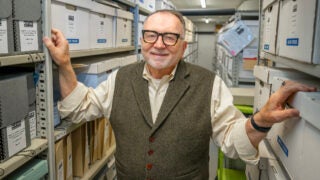
USC has implemented a lighting sensor program to lower energy consumption. (Photo/Olga Reznik)
USC announces vision for Sustainability 2020
Building on successful cost-effective practices, the new plan includes reduced water use and energy consumption
USC’s new Sustainability 2020 plan will provide the framework for the university’s ongoing efforts over the next five years to integrate sustainability into all facets of the university, including academic research, curriculum development, energy and water conservation and procurement.
The USC Sustainability Steering Committee, composed of faculty, staff and students, created the Sustainability 2020 plan as a roadmap for the university to meet rising environmental challenges through education, research, community involvement, conservation, transportation and waste diversion. Committee members included senior-level administrators, staff, students and faculty with expertise in sustainable practices or positions that enable them to play a large role in those efforts.
“Over the years, USC’s overall sustainability efforts have grown and intensified,” said David Wright, chair of the USC Sustainability Steering Committee and USC associate senior vice president for administrative operations. “The USC Sustainability office partnered with students, faculty and staff to create the Sustainability 2020 plan, demonstrating the university’s commitment toward integrating sustainable practices into all facets of campus life.”
Practical goals are in place
This new vision of sustainability builds on the university’s success in implementing cost-effective sustainable practices. The university has cut its water use by replacing about three-quarters of all campus faucets, toilets, urinals and shower heads with low-flow units, and implemented an innovative lighting sensor program to lower USC’s energy consumption in its largest parking structure.

“Practical objectives are key,” Wright said. “We worked closely with people on the leading edge of USC’s sustainability efforts to make sure that any targets we set were achievable and made sense economically.”
Sometimes goals have to be balanced with real-world constraints. Though USC has the infrastructure in place to use recycled or reclaimed water for irrigation and cooling towers, the Los Angeles Dept. of Water and Power will not extend a connection to campus for a few years. Similarly, restrictions on the purchase of energy from solar panel providers limit how the university can increase use of renewable energy.
The goals outlined in the plan meet or exceed national standards for university sustainable practices. Halli Bovia, sustainability program manager, led the effort to assess USC’s sustainability efforts against other universities such as Stanford, Cornell, Harvard, UCLA and the University of California, Berkeley. Using the nationally recognized Sustainability Tracking, Assessment and Rating System, also known as STARS, Bovia and her team were able to benchmark USC’s sustainability practices against other leading universities.
Engaged discussion and careful analysis resulted in several ambitious sustainability goals, including the reduction of greenhouse gas emissions by 20 percent from 2014 levels and diverting an additional 25 percent of waste from landfills by 2020.
The plan has received broad support from the USC community, including the Undergraduate Student Government, Graduate Student Government, the Academic Senate and Staff Assembly. In addition, the committee has shared the plan with the Office of the President, the Office of the Provost, Student Affairs and academic operations.
A top priority
USC Provost Michael Quick sees sustainability and climate change as “wicked problems” for research universities such as USC to focus research, creative and educational activities.
Sustainability 2020 provides a framework for progress and accountability to the USC community.
Michael Quick
“As USC rises to meet the powerful challenges of the 21st century, environmental sustainability must take priority in our teaching, research, operations and facilities,” Quick said. “Sustainability 2020 provides a framework for progress and accountability to the USC community, the greater Los Angeles area and even to the world on how we will focus our work in this critical area.”
Sustainability 2020 embraces the integration of sustainability into all facets of the university through achievable goals such as purchasing 20 percent of food from sustainable sources and decreasing potable water use by 25 percent.
“Over the long term, we believe sustainable procurement will save money, benefit the local economy and minimize damage to the environment,” said Lila Mauro, assistant vice president for business services. “The goals in Sustainability 2020 are practical and achievable and will help us build on our success in increasing campus-wide use of sustainable products in a cost-effective way.”
Additional steps
The next steps for Sustainability 2020 will be to identify and develop projects that will enable the university to achieve the goals outlined in the plan, said James Gibson, executive director of USC Environmental Health and Safety. USC’s departments, schools and facilities will need to work together to coordinate and implement these measures. Each proposed sustainability project will undergo evaluation, approval and funding processes by the different department heads before implementation.
Striving for a sustainable university will be an ongoing effort.
“We recognize that we can’t do everything,” Gibson said. “An important aspect of the Sustainability 2020 vision is that it identifies achievable, high-impact sustainability goals and allows us to find those projects and programs that will best help us to meet them. It’s about prioritization, feasibility and effectiveness.”



